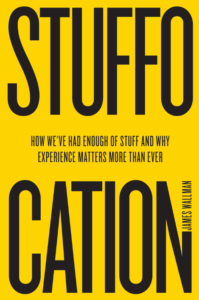Branding: The peculiar art and science of distilling something* down to its essence and giving it physical shape.
( *usually a product, place, service, or person).
Brands continue to shape humanity in ever more fundamental ways- even those who don’t torment ourselves over logos, typography and the message like some of us do.
Brands connect us, just as they drive us apart.
At a time when it seems increasingly difficult to rely on our elected leaders, when virus and violence remind us of our shared mortality and required humility, we need to focus on brands that bring us together.
Branding is a tool.
All of us use it.
Most use it in public.
Many use it for profit.
Some use it for power.
It is rarely used in private.
Humanity is a web.
It is a complex, intricately woven structure of cultures, races, and genders. A patchwork of beliefs, histories, world views and identities. A quilt of sublime beauty and unimaginable horror.
We are all part of one species, sharing one planet. And we inhabit a world in which any of our individual actions- what we buy, what we eat, what news we share, how we travel, what we throw away- affect everything else.
Everyone of us has a place. We all have a role to play. Most of us want to make the world a better place for ourselves, our neighbors, and our children.
In some shape or form, we all want to be part of something bigger than ourselves.
We all want to belong.
Branding used to be about ownership– about what belongs to us. Branding was about marking one’s possessions in public.
At some point, we discovered that the purchase, use, consumption (or even wasting) of a product could serve as a reflection of our worldview- our status.
Caviar | The Automobile | Champagne | Fur Coats | Beaver Hats
We have transitioned from wearing pelts for survival to wearing pelts for status. Attaching value to actions and the consciously public display of labels allows us to seek out the like-minded. People like us. Do things like this. The not so subtle art of clanning. The same class. The same wealth. The same team.
Our people. Where we belong.
Was this the moment where we surrendered to the brand?
Brands are the ultimate gatekeepers, trendsetters, and mass mind-shapers. They determine who and what we love, who and what we hate, what gets visibility, and what gets marginalized and buried.
Brands are the foundation of the attention economy; without them, we wouldn’t be debating how much information the human species can realistically process. We wouldn’t be deliberating about how to divide our attention between all the things that require it. Without brands, we would be hopelessly lost.
Without brands, would we be free?
Brands mark our status, signify our value, and let us broadcast to the world:
” This is who I Am “.
Consciously, unconsciously- possibly in permanent denial- we are living in a mega-branded reality in which the gestures, messages, imagery and actions of brands influence us more than we realize. They touch every facet of human life.
” I shop, therefore I am “.
This is how I dress.
This is how I speak.
This is what I do.
This is how I play.
This is how I pray.
This is who I love.
This is what I believe.
” This is who I am “.
Brands have a way of teasing out the best in us. They help us feel attractive, prosperous, and together. They make us feel part of a group, like we belong. They help us maintain optimism about ourselves and the world. Whether it’s flashy new pair of kicks, a new car or a motivating app, brands can dramatically alter our moods, our energy levels, and how we see ourselves.
Caveat: This power though is a double-edged sword.
It is to our benefit that we’re drawn to offerings that help us thrive, succeed, understand ourselves better, and achieve more happiness.
But are we just flaunting what we have got? Living a life of empty materialism and compensating for our insecurities? Or are the brands in our lives serving a deeper purpose, supporting our best possible selves, our strongest relationships, our most viable society?
” Choose your self-presentations carefully, for what starts off as a mask may become your face .”- ERVING GOFFMAN
To be continued..

